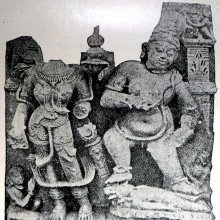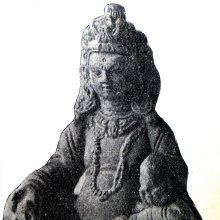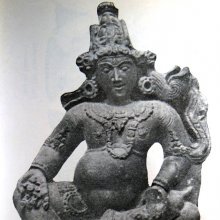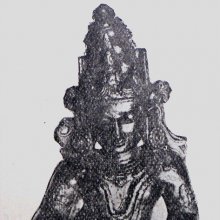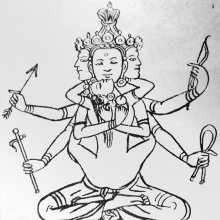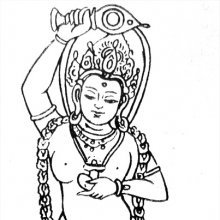Ucchushma, Ucchuṣma: 8 definitions
Introduction:
Ucchushma means something in Buddhism, Pali, Hinduism, Sanskrit. If you want to know the exact meaning, history, etymology or English translation of this term then check out the descriptions on this page. Add your comment or reference to a book if you want to contribute to this summary article.
The Sanskrit term Ucchuṣma can be transliterated into English as Ucchusma or Ucchushma, using the IAST transliteration scheme (?).
Alternative spellings of this word include Uchchhushma.
Images (photo gallery)
(+2 more images available)
In Hinduism
Shaktism (Shakta philosophy)
Source: Google Books: Manthanabhairavatantram1) Ucchuṣmā (उच्छुष्मा) is the name of a river and a Goddess, according to Tantric texts such as the Kubjikāmata-tantra, the earliest popular and most authoritative Tantra of the Kubjikā cult.—Accordingly, “She [i.e., the Goddess—Kubjikā] quickly went (to the place) where the auspicious river Ucchuṣmā (flows). It is in the Mahocchuṣma forest and transports the Divine and Mortal Currents (of the transmission). The goddess, endowed with the attributes of the divine Command, sports there where the lakes Mahocchuṣma and Nīla (are located). [...]”.—(cf. Ṣaṭsāhasrasaṃhitā verse 1.36-37, 4.5, 4.26-132)
2) Ucchuṣma (उच्छुष्म) is the name of a forest, according to the Śrīmatottara: “[... ] The goddess went quickly to where the great forest of Ucchuṣma is. (The goddess) called Ucchuṣmā resides there in the form of a river. She whose passion has been fulfilled (pūrṇakāmā) went where the great river Ucchuṣmā (flows). At that moment, the goddess Ucchuṣmā, beautiful in all (her) limbs, spontaneously appeared”.
According to the Ṣaṭsāhasrasaṃhitā: “Ucchuṣma is in the central aperture. At the left [peak] the Nīlahrada should be, and the Hrada [= Mahāhrada] at the right peak.... This pair of apertures, O Devī, is known as the peak of Trikūṭa. The third one is the (brahmarandhra), which is called the Forest of Ucchuṣma. From [this] Ucchuṣma a [twofold] stream comes forth, right and left. Where [this twofold stream] comes together, O Varārohā, there abides Parameśvarī. Because she can see [there every form] at will, that [place] is known as Kāmarūpa”.
3) Ucchuṣma (उच्छुष्म) (or Koṃkaṇā) is the name of the ‘secret seat’ associated with Kāmarūpa, one of the sacred seats (pīṭha), according to the Manthānabhairavatantra, a vast sprawling work that belongs to a corpus of Tantric texts concerned with the worship of the goddess Kubjikā.—Note: Another unusual feature of this setup is the addition of secret seats [i.e., Ucchuṣma], but this has not been done very systematically. One ‘secret’ seat is missing and only one ‘secret’ Siddha is mentioned. The purpose of this addition seems to be to integrate Koṅkaṇa into the scheme, not an entire set of alternative seats.
4) Ucchuṣmā (उच्छुष्मा) refers to one of the eight Kaula consorts (dūtī-aṣṭaka) associated with Pūrṇagiri or Pūrṇapīṭha (which is located in the northern quarter), according to the Manthānabhairavatantra.—[...] The eight Kaula consorts (dūtyaṣṭaka): Lokadūtī, Mahāmālā, Lalitā, Sāgarā, Laṃkadūtī, Lampā, Bhīmā, Ucchuṣmā.

Shakta (शाक्त, śākta) or Shaktism (śāktism) represents a tradition of Hinduism where the Goddess (Devi) is revered and worshipped. Shakta literature includes a range of scriptures, including various Agamas and Tantras, although its roots may be traced back to the Vedas.
In Buddhism
Tibetan Buddhism (Vajrayana or tantric Buddhism)
Source: Wisdom Library: Tibetan BuddhismUcchuṣma (उच्छुष्म) refers to one of the male Vidyā-beings mentioned as attending the teachings in the 6th century Mañjuśrīmūlakalpa: one of the largest Kriyā Tantras devoted to Mañjuśrī (the Bodhisattva of wisdom) representing an encyclopedia of knowledge primarily concerned with ritualistic elements in Buddhism. The teachings in this text originate from Mañjuśrī and were taught to and by Buddha Śākyamuni in the presence of a large audience (including Ucchuṣma).
Source: archive.org: The Indian Buddhist Iconography1) Ucchuṣma (उच्छुष्म) (also called Ḍimbha) refers to one of the various emanations of Akṣobhya having their Sādhana described in the 5th-century Sādhanamālā (a collection of sādhana texts that contain detailed instructions for rituals).—His Appearance is terrible; his Vāhana is Kuvera vomitting jewels; his Āsana is the pratyālīḍha.—Ucchuṣma also called Ḍimbha, being a variety of Jambhala, bears also the image of Akṣobhya on his crown. He may however, have the image of Ratnasambhava instead, and as an emanation of Ratnasambhava Jambhala will be described later. Several Sādhanas are devoted to his worship.
The Dhyāna (meditation instructions) of Ucchuṣma-Jambhala described in the Sādhanamālā as follows:—
“The worshipper should meditate himself as the god Ucchuṣma, who appears a child of five years and is dwarfish. He stands on a double lotus on the moon, is decked in ornaments of snakes and has a jewelled head-dress. He stands in the pratyālīḍha attitude and presses with his right leg the forehead of the sleeping Dhanada of yellow colour with his mouth vomitting out jewels. His left leg rests on the two legs (of Dhanada). He is nude, and his membrum virile is pointed upwards. He has a protruding belly, and has his eyes fixed on the kapala full of blood which he carries in his right hand against the chest. He holds in his left hand the mongoose vomitting out jewels,on his left thigh. His ears are large and unpierced and he has a crescent on his crown. His face is distorted with bare fangs, and his three eyes are red and round. His brows are distorted, and his brown hair rises upwards. He bears on his crown the image of Akṣobhya of blue colour displaying the earth-touching attitude”.
2) Ucchuṣma (उच्छुष्म) or Ucchuṣmajambhala refers to one of the various emanations of Ratnasambhava having their Sādhana described in the 5th-century Sādhanamālā (a collection of sādhana texts that contain detailed instructions for rituals).—His Āsana is the pratyālīḍha; his Appearance is terrible; his Vāhana is Kuvera.—This Ucchuṣma Jambhala is identical in form with the one already discussed under the emanation of Akṣobhya.—Note: also see Jambhala.
Ucchuṣma-Jambhala is described as follows:—
[Here also Ucchuṣma stands in the pratyālīḍha attitude with his left leg stretched forward on the forehead of Kuvera while the right tramples upon his two legs. He is terrible to behold, with protruding belly, bare fangs and the snakes for ornaments. He holds the kapāla full of blood against his chest in the right hand and looks eagerly at it with three eyes The left hand as usual holds the mongoose.]
Ucchuṣma Jambhala is rarely represented and his images are not known except the one at Sarnath already described under the emanations of Akṣobhya. This unique image shows all the characteristic features of the god as obtained from the Sādhanas. The figure shows his consort Vasudhārā in the left, but the effigy of neither Akṣobhya nor Ratnasambhava can be seen on his head. It is Amitābha who is there. Nevertheless, this is the only figure known to students of iconography, as representing Ucchuṣma Jambhala.

Tibetan Buddhism includes schools such as Nyingma, Kadampa, Kagyu and Gelug. Their primary canon of literature is divided in two broad categories: The Kangyur, which consists of Buddha’s words, and the Tengyur, which includes commentaries from various sources. Esotericism and tantra techniques (vajrayāna) are collected indepently.
Languages of India and abroad
Sanskrit dictionary
Source: DDSA: The practical Sanskrit-English dictionaryUcchuṣma (उच्छुष्म).—Confusion.
Derivable forms: ucchuṣmam (उच्छुष्मम्).
Source: Cologne Digital Sanskrit Dictionaries: Edgerton Buddhist Hybrid Sanskrit DictionaryUcchuṣma (उच्छुष्म).—name of a deity: Mahāvyutpatti 4332.
Source: Cologne Digital Sanskrit Dictionaries: Monier-Williams Sanskrit-English Dictionary1) Ucchuṣma (उच्छुष्म):—[=uc-chuṣma] mfn. (ud-śuṣma [√2. śuṣ]) one whose crackling becomes manifest (said of Agni), [Taittirīya-saṃhitā; Atharvaveda-pariśiṣṭa]
2) [v.s. ...] Name of a deity, [Buddhist literature]
3) [v.s. ...] [Taittirīya-saṃhitā]
4) Ucchuṣmā (उच्छुष्मा):—[=uc-chuṣmā] [from uc-chuṣma] f. Name of a plant, [Kauśika-sūtra]
[Sanskrit to German]
Sanskrit, also spelled संस्कृतम् (saṃskṛtam), is an ancient language of India commonly seen as the grandmother of the Indo-European language family (even English!). Closely allied with Prakrit and Pali, Sanskrit is more exhaustive in both grammar and terms and has the most extensive collection of literature in the world, greatly surpassing its sister-languages Greek and Latin.
See also (Relevant definitions)
Partial matches: Uc.
Starts with: Ucchushmabhairava, Ucchushmajambhala, Ucchushmakalpa, Ucchushmanadi, Ucchushmarudra, Ucchushmashastra.
Query error!
Full-text (+38): Ucchushmabhairava, Ucchushmarudra, Ucchushmakalpa, Mahocchushma, Ucchushmashastra, Nishushma, Ucchushmajambhala, Ucchushmanadi, Nilahrada, Dimbha, Sagara, Lampa, Lokaduti, Mahamala, Lamkaduti, Hrada, Nila, Mahahrada, Kamarupadhara, Kravyada.
Relevant text
Search found 9 books and stories containing Ucchushma, Uc-chushma, Uc-chuṣma, Uc-chuṣmā, Ucchuṣma, Ucchusma, Ucchuṣmā; (plurals include: Ucchushmas, chushmas, chuṣmas, chuṣmās, Ucchuṣmas, Ucchusmas, Ucchuṣmās). You can also click to the full overview containing English textual excerpts. Below are direct links for the most relevant articles:
Rig Veda (translation and commentary) (by H. H. Wilson)
Rig Veda 10.97.8 < [Sukta 97]
Shurangama Sutra (with commentary) (English) (by Hsuan Hua)
Ucchushma : the fire element < [Chapter 2 - Twenty-five Means to Enlightenment]
Establishing the bodhimanda < [Chapter 2 - Establishing the Bodhimanda]
Manjushri examines the seven elements < [Chapter 3 - Manjushri Selects the Organ of Entry]
Atharvaveda ancillary literature (Study) (by B. R. Modak)
Part 1.18 - The Purva Asadha (Sagitarii) < [Chapter 2b - A Topical Analysis of the Atharvaveda-Parisistas]
Part 1.29 - Development of the constellations across Jyotisha-shastra < [Chapter 2b - A Topical Analysis of the Atharvaveda-Parisistas]
Part 5 - State of Knowledge in the Atharvaveda-Parisistas < [Chapter 2c - General study of the Atharvaveda-Parisistas]
The Indian Buddhist Iconography (by Benoytosh Bhattachacharyya)
Figure 130 - Emanations of Akṣobhya: Ucchuṣma-Jambhala
Figure 176-179 - Emanations of Ratnasambhava: Jambhala
Atharvaveda and Charaka Samhita (by Laxmi Maji)
Treatment of Impotency < [Chapter 3 - Diseases and Remedial measures (described in Atharvaveda)]
Medicinal herbs and plants in the Atharva-veda < [Chapter 3 - Diseases and Remedial measures (described in Atharvaveda)]
Lakulisha-Pashupata (Philosophy and Practice) (by Geetika Kaw Kher)
Locating the Lakulisa-Pasupata rites in the world of Saivite rituals < [Chapter 3 - The Ritualistic Context]
Overall Structure and Methodological considerations < [Introduction]
